Watercolor artists can explore vibrant washes through sunset silhouettes with bold oranges and purples, layered mountain vistas, and wet-on-wet florals that bloom with life. Expressive seascapes capture wave energy, while urban sketches combine ink and wash. Create cosmic galaxies, whimsical wildlife, and seasonal tree studies with gradient techniques. Weather effects like rain and fog add atmosphere, turning happy accidents into artistic opportunities. These techniques await your brush, ready to transform ordinary paper into extraordinary worlds.
Key Takeaways
- Create sunset silhouettes by blending vibrant oranges, pinks, and purples while wet for dramatic sky effects.
- Experiment with wet-on-wet techniques for flowing floral studies that showcase natural-looking blooms with dynamic color interactions.
- Apply bold strokes and splatter techniques in seascapes to capture waves, sea spray, and the movement of water.
- Embrace “happy accidents” by allowing colors to mingle spontaneously and incorporating unexpected outcomes into your artwork.
- Develop galaxy paintings using wet-on-wet techniques, sponges, and white paint splatters for celestial effects.
Sunset Silhouettes: Creating Dramatic Sky Washes
When artists seek to capture nature’s most breathtaking moments, sunset silhouettes stand out as one of the most dramatic and accessible watercolor techniques to master. The magic begins with a graduated wash, applying rich hues at the top and adding water as you move toward the horizon. Talk about a show-stopper!
Vibrant washes of oranges, pinks, and purples blend together while wet, creating that jaw-dropping sunset effect we all love. For extra pop, try a variegated wash by introducing deep blues or indigos—just keep those contrasting colors separate to avoid muddy results!
Once dry, paint solid black silhouettes in the foreground. Trees, buildings, or even people work perfectly!
For mind-blowing depth, try layering washes—let the first dry, then add another for expressive strokes that’ll make your painting sing.
Layered Landscape Techniques for Mountain Vistas
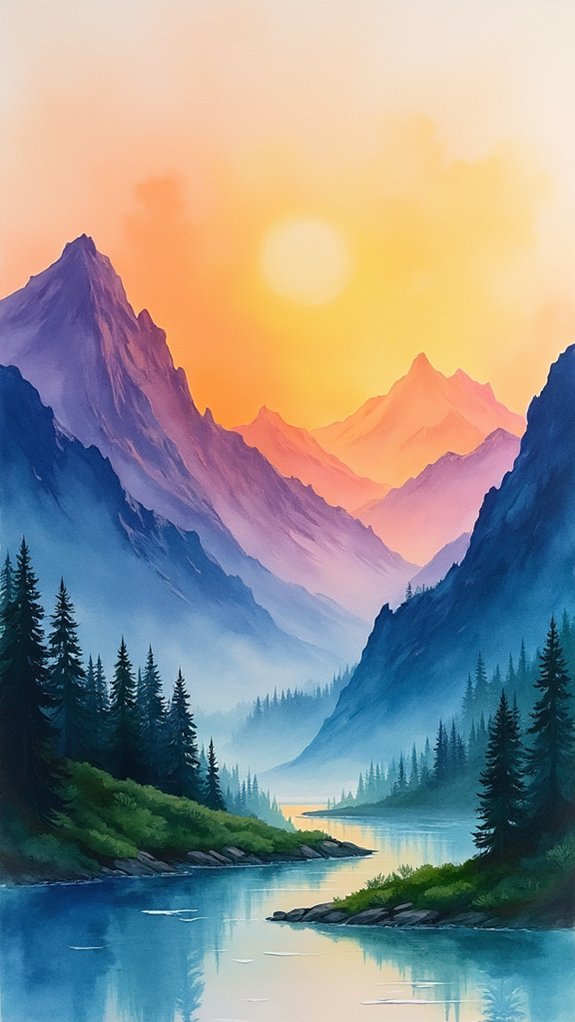
From dramatic sunsets to majestic heights—mountain vistas offer watercolor artists a whole new world of creative possibilities!
Creating depth and dimension in mountain scenes requires patience and layering techniques that capture nature’s grandeur.
Mountain
- Start with flat washes in lighter, cooler colors for distant mountains, letting each layer dry completely.
- Apply graduated washes to show atmospheric perspective—cooler tones in the background, warmer colors up front.
- Blend vibrant colors in variegated washes to capture rocky textures and rugged terrain.
- Use wet-on-dry technique for crisp details and negative painting to make mountains pop.
Expressive strokes in the foreground mountains add character, while layered mountain vistas develop naturally through careful application of these techniques.
Don’t rush—each layer contributes to that breathtaking scene!
Flowing Floral Studies With Wet-On-Wet Blending
Watercolor artists can create stunning floral effects by mastering vibrant petal techniques that bring blooms to life on the page.
Using wet-on-wet blending, painters can watch colors dance and merge, creating expressive botanical gradients that mimic nature’s own gentle shifts.
The magic happens when bright colors are applied quickly to damp paper, allowing the artist to control how much the hues blend together or stand apart, just like real flowers showing both unity and individual character.
Vibrant Petal Techniques
The magic of wet-on-wet blending transforms ordinary watercolor flowers into extraordinary works of art. Artists achieve this by thoroughly wetting the paper first, creating a perfect canvas where colors dance and merge with joyful abandon! The technique allows for expressive, natural-looking petals that seem to bloom right before your eyes.
- Start with lighter colors as your base, adding darker shades while the paper remains damp for incredible depth.
- Mix colors directly on the paper—watching reds and yellows swirl into vibrant oranges is pure artistic magic!
- Switch between brush sizes to create various textures and petal shapes.
- Control your water-to-pigment ratio carefully—too much water dilutes vibrancy, too little prevents proper blending.
Mastering these techniques brings flowers to life through watercolor, capturing their delicate beauty through thoughtful textures and rich color shifts.
Expressive Botanical Gradients
When artists desire to capture the flowing essence of nature’s botanical wonders, expressive gradients offer a perfect solution! The secret lies in thoroughly wetting the paper first, creating a canvas where vibrant color can dance freely.
In watercolor painting, this wet-on-wet technique transforms ordinary floral studies into magical displays of color! Artists can create stunning effects by dropping rich pigments onto damp paper and watching them blend together—just like real flower petals unfurling in morning dew!
Experimenting with layers builds amazing depth and dimension, while different brush sizes create varied textures that bring botanical subjects to life. The real magic happens when colors are allowed to flow naturally, without too much fussing.
This expressive approach captures that spontaneous “wow factor” that makes watercolor paintings of flowers so incredibly enchanting!
Expressive Seascapes: Capturing Wave Energy
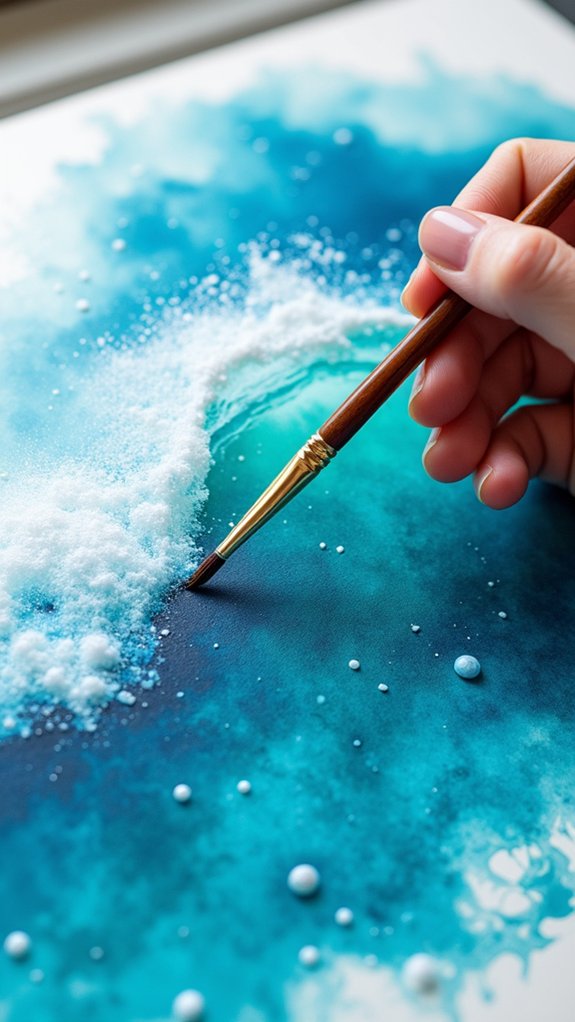
Few artistic subjects capture imagination quite like the powerful dance of ocean waves. Through vibrant washes and expressive brush strokes, artists can bring the raw energy of the sea to life on paper.
Wet-on-wet techniques create that magical fluidity that makes water feel real and dynamic.
To create stunning seascapes that practically splash off the page:
- Start with graduated washes—darker blues at the horizon, gradually lightening as waves approach the viewer
- Mix variegated washes of blues, greens, and whites to mimic sunlight dancing across water
- Apply bold, sweeping strokes for major waves and choppier marks for turbulent areas
- Add splatter techniques for sea spray and foam, giving your painting that exciting sense of movement
Blending colors while the paper remains damp allows pigments to mingle naturally, just like real waves do!
Urban Sketching With Line and Wash Combinations
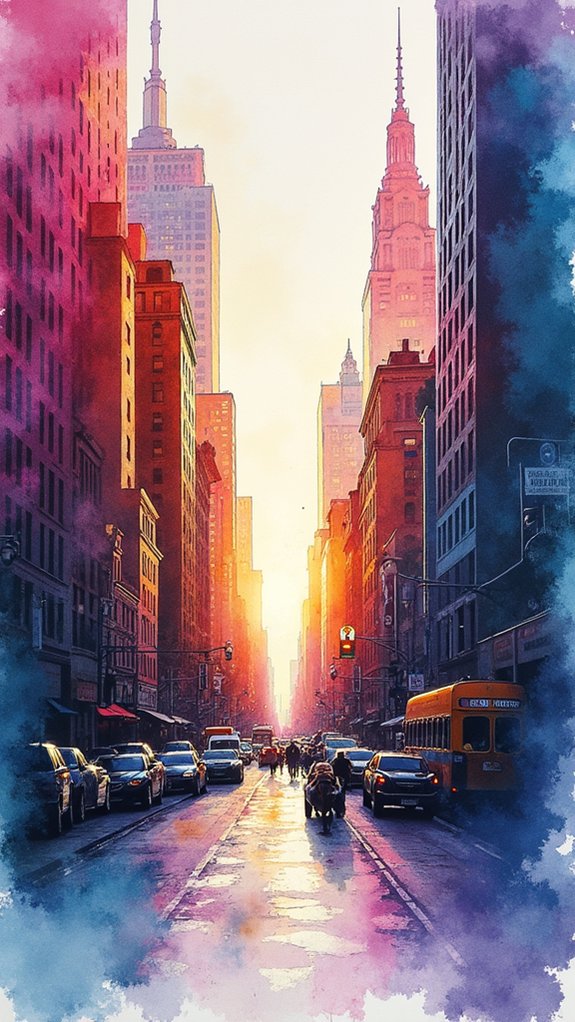
Urban environments pulse with life, character, and endless storytelling opportunities for watercolor artists willing to explore them. The dynamic combination of pen lines and watercolor washes captures the essence of city scenes with amazing energy!
Quick execution is key in urban sketching, where artists blend expressive strokes with vibrant washes to create depth and dimension in their paintings. Loose lines convey movement while watercolor washes add atmosphere.
| Urban Sketching Tips | Benefits |
|---|---|
| Use watersoluble ink | Lines blend seamlessly with paint |
| Start with light washes | Builds layers of transparency |
| Add dark accents last | Creates focal points and drama |
This approach frees artists from perfectionism, letting them focus instead on capturing the bustling energy of street corners, café patios, and towering architecture through spontaneous, confident strokes.
Abstract Color Fields With Variegated Wash Effects
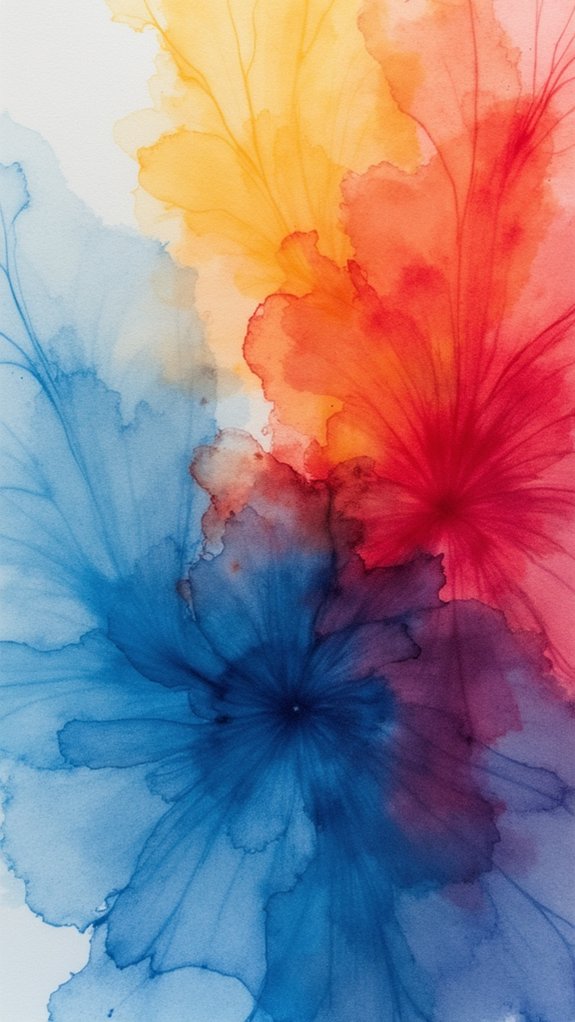
Variegated wash techniques open up a world of possibilities for creating abstract color fields where colors dance and mingle with magical unpredictability.
Artists can achieve fluid shifts by tilting wet paper and allowing complementary hues to flow together, creating moments where colors kiss at the edges without turning muddy.
The secret to breathtaking abstract watercolors lies in layering color intensity—starting with light, transparent washes and gradually building up richer, more concentrated pigments in specific areas to create visual depth that practically jumps off the page.
Creating Fluid Transitions
Creating fluid shifts between colors is where watercolor truly shines as a medium. When artists create fluid changes, they transform simple paintings into vibrant washes that dance across the watercolor paper. The key lies in proper preparation and timing!
- Start with thoroughly wet paper to allow colors to blend without creating harsh lines.
- Apply different colors while the surface remains damp, tilting your paper to encourage mingling.
- Use a wet brush to gently drag pigment across regions, creating visually engaging gradients.
- Experiment with various water-to-paint ratios for unexpected effects and textures.
These expressive strokes require patience—letting each layer dry completely before adding the next.
Don’t be afraid to make mistakes! Sometimes the most beautiful changes happen when you least expect them, turning happy accidents into artistic intentions.
Layering Color Intensity
Many artists discover that the true magic of watercolor emerges through layering, especially when creating abstract color fields with variegated wash effects. This technique involves starting with lighter shades on a wet surface, allowing colors to blend harmoniously before adding darker tones.
Each layer must dry completely before the next is applied to add depth without muddiness. Control over water is vital – too much creates puddles, while too little prevents proper flow.
Artists often tilt their paper, encouraging vibrant washes to mingle naturally while keeping complementary colors separated. Expressive strokes with various brush sizes create dynamic interactions, and dropping concentrated pigment into wet areas produces unique textures that simply can’t be planned!
The process feels like conducting a colorful symphony where each layer builds upon the previous one, creating rich, luminous results.
Galaxy Paintings: Cosmic Night Sky Techniques
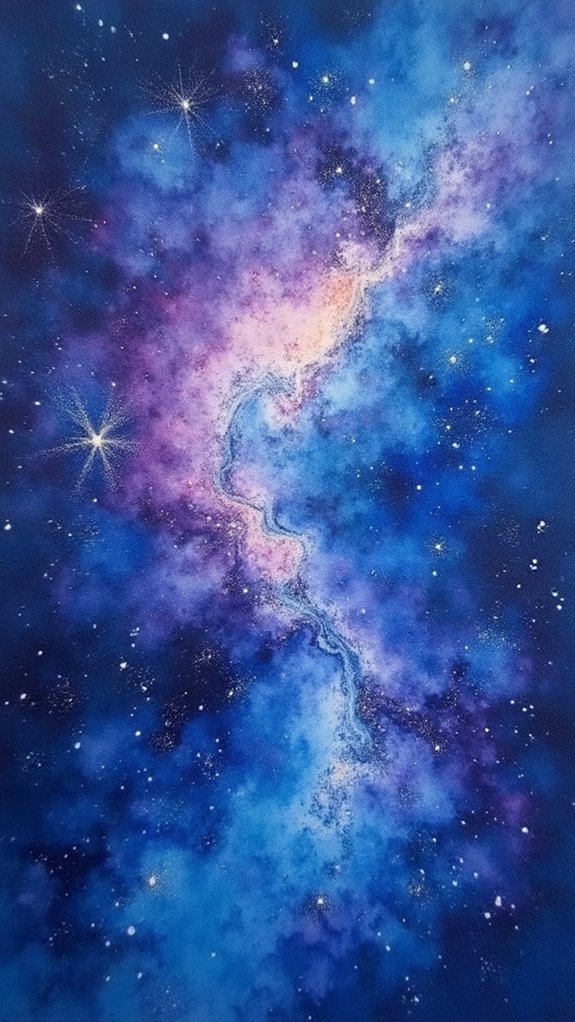
When artists want to capture the breathtaking beauty of space, watercolor offers a perfect medium for creating dreamy cosmic scenes. The wet-on-wet technique adds depth to create vibrant night skies where different shades of blues, purples, and blacks blend together.
Artists achieve the desired cosmic effect by applying washes of color on damp paper, letting the colors mingle naturally, just like real nebulae!
- Sponge or crumpled plastic wrap can be dabbed with lighter colors to create stunning star clusters
- Variegated washes blend multiple colors together, creating smooth space-like gradients
- White paint splattered with a toothbrush makes perfect distant stars
- Adding expressive strokes with a fine brush creates shooting stars and planets
These visual effects transform ordinary paper into windows to the universe—no telescope required!
Whimsical Wildlife With Bold Brushwork
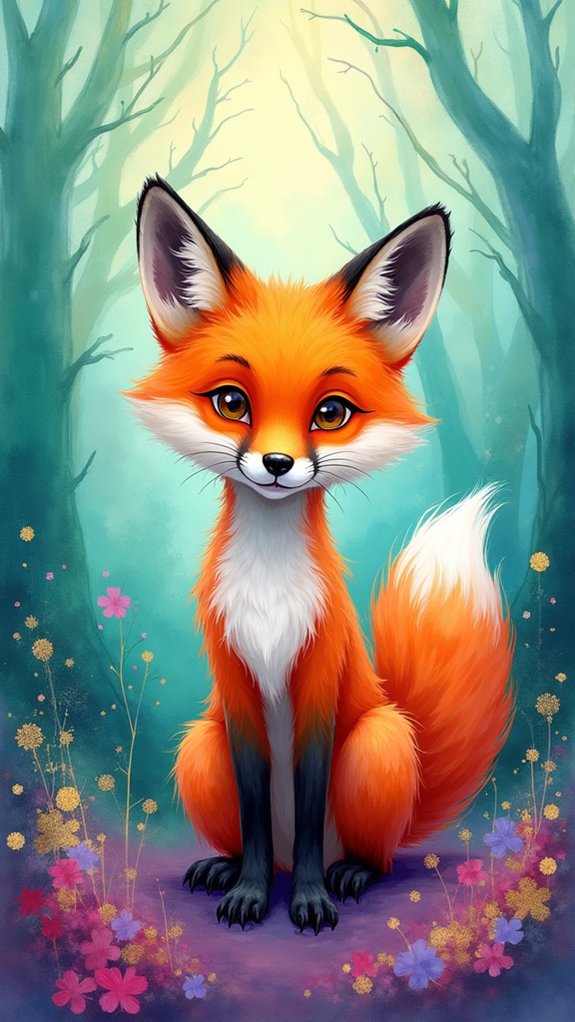
Vibrant wildlife takes on a magical quality when artists embrace bold, expressive brushwork in their watercolor creations. These dynamic representations come alive through varied line weights and loose strokes, giving each animal a unique personality and energy that practically leaps off the page!
Whimsical wildlife illustrations benefit enormously from vibrant washes that create lively backgrounds. Artists can use wet-on-wet techniques to achieve soft, blended colors that mirror nature’s flowing beauty.
Layered washes breathe life into whimsical creatures, creating dreamlike habitats where imagination flourishes.
What makes these pieces truly engaging is the addition of playful elements—think purple foxes or teal elephants with exaggerated features! Unexpected color combinations transform ordinary animals into extraordinary characters, inviting viewers into a world where imagination rules.
For young artists, these bold brushwork approaches offer freedom to express wildlife in ways that are both fun and artistically rewarding.
Seasonal Tree Studies Through Gradient Washes

Throughout each changing season, trees transform into nature’s most enchanting watercolor subjects, perfect for exploring the magic of gradient washes.
Artists can capture the dramatic shifts from summer’s deep greens to autumn’s fiery display using expressive strokes and vibrant hues that breathe life onto paper.
The wet-on-wet technique works wonders for these seasonal trees, creating soft, blended edges that mimic real-life canopies with amazing depth.
Try these approaches:
- Start with darker colors at the top, gradually adding water as you move downward
- Mix complementary colors for variegated washes that show spring blossoms or fall foliage
- Use flat washes for backgrounds to make your trees pop against a smooth backdrop
- Experiment with color changes to show how a single tree evolves through the seasons
Atmospheric Weather Effects: Rain, Fog and Mist
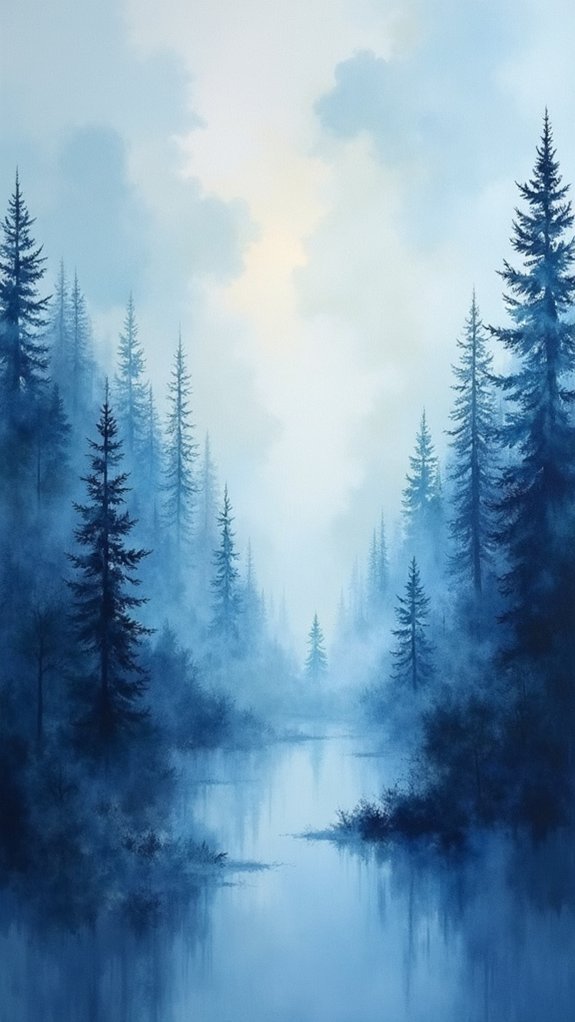
Watercolour’s magical ability to capture atmospheric conditions makes it perfect for painting weather effects that dance across the page. Using the wet-on-wet technique, artists can create visually appealing rain scenes by applying light washes of blue or grey that blend softly together.
To create depth and dimension in foggy environments, try layering diluted washes of pale colors, allowing edges to blur naturally. Mist effects come alive through expressive brush strokes that suggest rather than define, shifting from darker to lighter areas.
Want to enhance the illusion of rainfall? Incorporate drips and runs by tilting your paper while paint is still wet!
Negative painting techniques help define shapes within the atmosphere, adding texture to your weather scenes. Rain, fog, and mist—nature’s most mysterious elements—become your artistic playground.
Frequently Asked Questions
How Do You Prevent Watercolor Paper From Buckling?
Preventing watercolor paper buckling requires proper paper stretching techniques. Heavier watercolor weight options reduce issues. Other buckling prevention methods include primed paper benefits, using tape effectively, and considering drying time factors when layering.
What Brushes Work Best for Detailed Watercolor Work?
For detailed watercolor work, round brushes with fine points excel. Synthetic brushes maintain precision, while natural brushes hold more water. Proper brush care preserves tip sharpness essential for intricate techniques.
How Long Should Watercolor Paintings Dry Between Layers?
Watercolor layer drying times vary from 5-30 minutes depending on paint consistency, paper types, and humidity effects. Ideal temperature enhances color blending. Different layering effects require complete drying between applications.
Can You Fix Mistakes in Watercolor Paintings?
Watercolor mistakes can be fixed through color correction techniques, lifting and restoring pigment, layer adjustments, fixing edges, and rescuing details. Artists often use watercolor mediums, gouache, texture experimenting, and careful color mixing.
Which Watercolor Brands Offer the Best Lightfastness?
Brands offering superior lightfastness ratings include Winsor & Newton, Daniel Smith, and Schmincke. Professional grades outperform student grades in pigment quality and color vibrancy, though price ranges reflect these differences in transparency levels.
Conclusion
Watercolor opens a world of creative possibilities for artists of all levels. From dreamy sunset silhouettes to splashy seascapes, these ten ideas offer jumping-off points for your next artistic adventure. Remember, watercolor thrives on happy accidents and spontaneous moments! So grab your brushes, let those pigments flow, and watch the magic unfold on your paper. Your unique artistic voice is waiting to splash onto the scene!


Leave a Reply